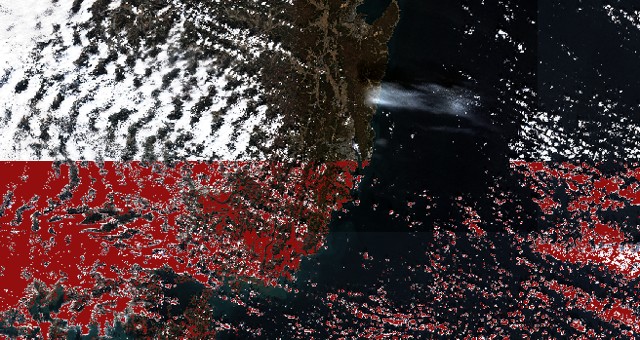Picture this: me and my boss staring at a computer screen, six months into a project. I had just spent 29 minutes bragging about my work. Well, to be honest, he wasn’t really staring at the screen – he was looking at me in complete disbelief.
Let me back up a bit. I was fresh out of academia, feeling pretty good about my seven years of computer vision research and 40+ published papers. Most of my work was focused on Ultrasound medical imaging. Now, if you remember, it looks like somebody de-tuned an old analogic TV! If I could encode the expertise of highly trained radiologists, how hard could it be to encode some common sense facts?
My new job seemed straightforward: identify clouds in satellite images. You know, those white fluffy things we see every day against the blue sky? How hard could it be to tell them apart from water or land? One little caveat, my images were taken from high above.
So I dove right in. The task was clear, image segmentation. More precise, semantic segmentation. I gathered the right datasets, pinged up our partners and discuss in length about segmentation ground truth, set up fancy processing pipelines, time-wise and space-wise train/val/test data splitting and requested enough computing power to run a small space program. I filled spreadsheets with numbers and kept sending my boss updates – bar charts, box plots, line graphs with error bars, the works. Each experiment showed tiny improvements, but something felt off. The results weren’t as good as they should’ve been for such a “simple” task.
Can you show me an actual image?
Then came that meeting. I started strong, throwing around big words about medical imaging experience, discussing bias-variance trade-offs and how I implemented the best-practices in the CV field. The same practices that earned recognition top-tier academic journals! My boss sat there quietly for 29 minutes while I showed him chart after chart.
Finally, he asked one simple question: “Can you show me an actual image?”
I proudly pulled up my latest model, wired up some OpenCV and hit Control+Enter with confidence. And there it was – my algorithm’s masterpiece: clouds with perfectly straight edges, like someone had drawn them with a ruler.

What my boss saw!* You get the general idea. In red, are the detected clouds, overlapped on top of the “regular” image. Note how sharp, the edges of the clouds, are!
[* Dramatized, of course. For reference, this is a fairly recent Sentinel 2 image, “manually” painted for dramatic effects.]
The silence was deafening. My boss, probably counting backward from ten and wondering whether to call HR, finally spoke: “When was the last time you saw a cloud with edges that looked like they were drawn with a ruler?”
I don’t remember much after that, but they kept me on the project. Three things stuck with me:
- Life has a funny way of serving humble pie right when you need it most.
- Whatever machine learning problem you’re working on right now is always the hardest – because all the others are either solved, irrelevant, or too expensive.
- Most importantly: Always. Look. At. The. Data.
These days, I spend weeks just browsing through images, texts, or data statistics before jumping into any coding. Yeah, I still catch myself bragging sometimes right before life pulls the rug out from under me. But at least now I never find myself in a situation where my boss and I discover together just how badly the AI is performing. I discover it first!
Always look at the data!
P.S. Cloud detection is apparently still a hard task in EO, some made a career from dunking on Optical EO folks and their pesky clouds!!
P.P.S. If anyone knows a foolproof way to stay humble, please share it with the rest of the class!
Follow me on LinkedIn for more hard-earned learning lessons!
